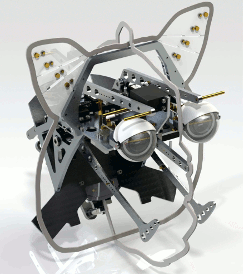As far as factory visits go, a trip to Artem’s West London headquarters has to be one of the most surreal.
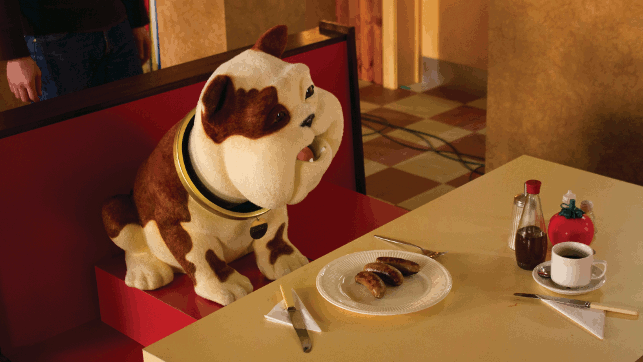
The animatronic nodding Churchill Insurance dog
In one area of its 20,000sq foot workshop, prosthetic wounds are being hand sculpted and life-like dead bodies moulded before being hung on a rail. In another, a robot arm is carving standing stones whilst a CNC machine is churning out oversized foam hammers. And just outside the workshop doors, potatoes are exploding whilst being filmed.
Artem is in the business of physical special effects (SFX). Its 28 employees, who consist of a mix of artists, designers, engineers and technicians, realise the visions of a raft of clients in the creative industries producing everything from animatronic robotic puppets and atmospherics through to pyrotechnics and sculpture.
Just in the past year Artem has created, amongst other projects, prosthetics and pyrotechnics for the action film ‘Welcome to the Punch’, a talking toilet for a Water Aid television advert, a life-like beating heart for the Casio G-Shock watch campaign, a giant floating sculpture of a swimmer to launch the 2013 PruHealth World Triathlon Grand Final, various props for the London theatre production of Charlie and the Chocolate Factory and an animatronic hand puppet of a Gremlin, from the 1984 film ‘Gremlins’, for a Snickers advert.
Considering it’s only the second day back at work of 2014, this is shaping up to be a busy year for Artem too. The workshop is a buzz of activity with work underway for a forthcoming Shakespearean film adaptation (hence the wounds, bodies and standing stones) and eleven 3-metre high cartoon-style puppets for the opening of one of the Middle East’s most sophisticated sporting arenas.
All these props go against the supposition that CGI and digital SFX would kill off physical SFX. ‘Real’ objects are still very much in demand but what has altered is the way in which they are brought to life. “Our business has changed over the last 10 to 15 years.
Before then we worked in the traditional method of hand finishing and hand building,” explains Mike Kelt, Artem CEO and SFX supervisor, who co-founded the company 26 years ago after a nine year stint in the BBC’s special effects department.
“From our point of view, the writing was on the wall about ten years ago and we recognised that we had to move into the 3D world. Whereas before something may have been sculpted in clay or wax or fabricated in timber, for instance, now we’ll draw it up in the computer usually and then output it to a machine whether that’s a CNC machine, router, robot arm or 3D printer.”

The Octobus, which was created for the opening ceremony of the London 2012 Olympic Games
Working in this way has speeded up the design process not least because different aspects of a project can be worked on concurrently.
Taking the iconic nodding Churchill Insurance dog as an example, Artem created the original puppet of the dog years ago. The client then opted for a digital Churchill but recently returned to Artem for a new version of the physical animatronic puppet.
Tools for the job
With new tools in its arsenal, the Artem team could improve on its previous process of creating the Churchill dog, which was all done by hand.
“Before we couldn’t really work on the internal mechanical skeleton until the outer shell was complete,” comments Kelt. Whereas, now, if you draw it on the computer you know exactly what the dimensions of all parts are going to be so, while one process makes the outer skin, another can construct the inside knowing that it’ll all fit at the end of the day.
Modelling an object on the computer first also ensures that when it comes out of the machine at the other end, it will be exactly like that digital model and, if needed, dozens of replicas can be machined.
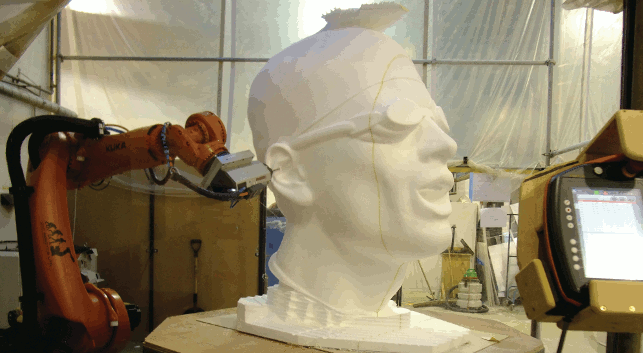
The Kuka robot arm carving out the giant swimmer used for launch of the 2013 PruHealth World TRiathlon grand Final
For instance, the Kuka robot arm is currently carving out identical standing stones from chemiwood for the Shakespeare film. Previously, these would have been sculpted by hand resulting in slight variations to each stone.
But does this mean that technology and new machinery is superseding the traditional skills of a sculptor? “To some extent we have cut out this skill but there are projects where they are still very much utilised,” says Kelt.
For instance, Artem recently created a lifelike 56 foot whale for a forthcoming film. The project began in the sculpture department where a one metre scale model or maquette was crafted by hand.
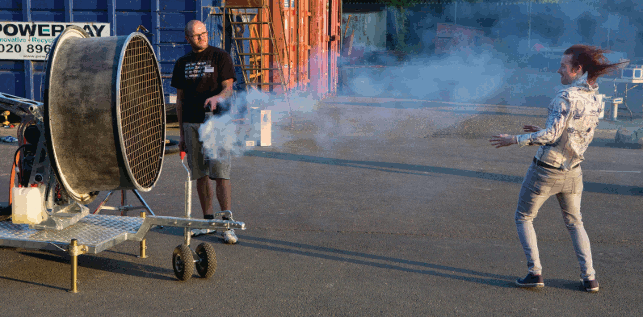
A wind machine that Artem developed in-house and now sells
Following client approval it was then scanned using a hand scanner and output to the computer where the 3D model was manipulated before files were sent to the robot arm, which carved the huge structure out in sections.
“Traditional craft skills are still paramount as a trained sculptor really understands physical 3D space. A 3D person doing it on the computer doesn’t always have that sculpture skill – they don’t really entirely understand what it is they are dealing with because at any one moment the model is only ever a 2D image. So, sometimes it is better to have a model sculpted physically first,” comments Kelt.
Selecting the right process
Really what this all amounts to is that there is no set path that all Artem’s projects follow and the project itself will determine how the team go about doing it.
“It is very much about trying to look at the problem and then figuring what the best way to go about it is,” confirms Kelt.
Halo 4 is just one example of the range of processes used in any one project. It kicked off with Microsoft briefing Artem to take the Master Chief from inside its Halo 4 video game and bring it to life in a full size suit that an actor could wear.
Four suits were needed for the various Halo 4 launch events taking place throughout Europe. Two years previously Artem had created two suits for the Halo Reach game but the main difference now is that they had longer to deliver the project – six weeks as opposed to just ten days!
Although these Halo Reach suits looked great, they were heavy and quite inflexible having been made with a combination of fibreglass and thick rubber. This time round, the Artem team wanted to demonstrate what could be achieved with a little more time.
The aim was for the actor to be able to get into the suit quickly and for it to be comfortable, highly flexible and deceptively lightweight.
Microsoft sent the 3D files over from America, which then had to be initially manipulated in Autodesk Maya. “Basically, with characters in a video game the lines just don’t join up and consequently they are full of holes.
This had to be sorted out in Maya and then the model chopped up into bits before being exported to SolidWorks where they were further worked on before being sent to the machine,” explains Kelt.
In terms of the machines, different ones were used depending on what was required. For instance, the head was split up into four pieces and output to the Dimension 3D printer. “Putting it in the 3D printer was quite a good way of doing that section as it was small enough and the machine could do the inside and outside shape at the same time,” adds Kelt.
Other ‘hard parts’ of the suit, including the chest and arm pieces, were carved on the CNC router as this process provided the best finish. These parts were then assembled, hand finished and moulded to produce a full set of silicone jacket moulds from which light weight fibreglass or rubber parts were produced.
The suit itself was clay sculpted over a body cast of a 6’6” person. This was moulded in sections from which Artem was able to produce a black reinforced foam latex under-suit. The various hard parts were then fixed to this suit. The look was complete with a gun, helmet (which included two fans inside to enable the actor to breathe), gloves and shoes.
“So although the suit is made up of lots of different parts, when it comes to putting it on there are only four or five items,” comments Kelt.
The first Halo 4 suit left the production line four weeks after it was started, with the remaining three following in one week intervals. All four were then boxed and shipped to the different launch events. One has since returned and makes a formidable presence at Artem’s front door.
Challenging job
As Kelt explains, another major challenge in any project is the client’s budget. “Over the years budgets have generally become tighter so you have to figure out what can be achieved for the amount of money you’ve got and the time you’ve got to do it in.
There’s no doubt that new technology – the 3D printer and the robotic arm etc. – can make a difference.
“At the same time, another big part of the job is all down to experience. It doesn’t matter what machines you’ve got littering the workshops, if you don’t have the knowledge and experience to kick the ball in the right direction in the first place, you’re never going to get it into the goal. That’s crucial and the budget is probably the biggest bit of that.”
So, although physical SFX comes across as an incredibly varied and fun industry to work in, there’s no doubt that it’s extremely demanding and challenging. “It’s an adrenaline rush and all about solving problems. It’s exciting and hugely varied but the tight deadlines and fast turnaround make it an unsuitable occupation for the easily stressed,” admits Kelt.
In fact, when asked to name one of Artem’s most challenging projects, Kelt laughs saying “Where do I start?”
However, he admits that the work that was carried out for the opening and closing ceremonies of the London Olympic and Paralympic Games were challenging for the sheer scale of what had to be achieved. The entire workshop, both in its London and Glasgow division, had to be given over in the lead up to July 2012.
Working closely with the artistic director Danny Boyle, the Artem team brought his vision to life by producing 20 separate pieces including a 60 foot Voldemort puppet, enormous trampoline beds, the Child Catcher’s carriage, fire bikes, giant industrial chimneys and a full-size lightweight house. Not to mention all the weather, smoke pyrotechnics and molten metal effects.
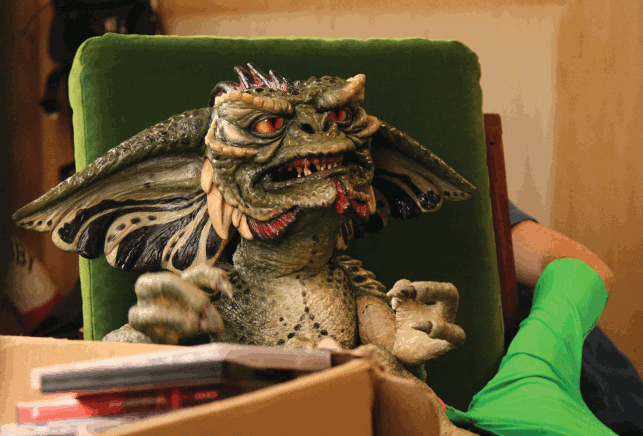
An animatronic hand puppet of a Gremlin that Artem recently developed for a Snickers advert
The most demanding piece was the Octobus, an electric bus based on the design of the Beatles ‘Magical Mystery Tour’ with a giant transparent Octopus inflating out of it with PVC tentacles reaching 22m long and 1.7m diameter.
Amongst all this, Artem also designed and manufactured its own petrol-driven wind machines that were used at various points during the ceremonies to create an effect and also to blow up the props, including the giant Paralympic inflatable symbol. This product has since been launched by Artem and is now available for sale to the global market.
A visit to Artem leaves one feeling rather overwhelmed that a 28 strong company is capable of creating such creative and staggering work. But Kelt is in no doubt that under its roof are all the resources needed to deal with whatever a client may throw at them.
“There is nothing that couldn’t be done here. We have everything from the digital stuff, 3D printers and machines through to the hand skills, precision engineering and high finish spray capabilities. It’s all here and just waiting for projects to drop in.”
//www.youtube.com/embed/j-resyAnlpI
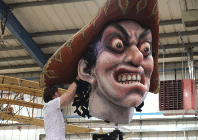
How Artem creates special effects using cutting-edge design & engineering techniques
Default



